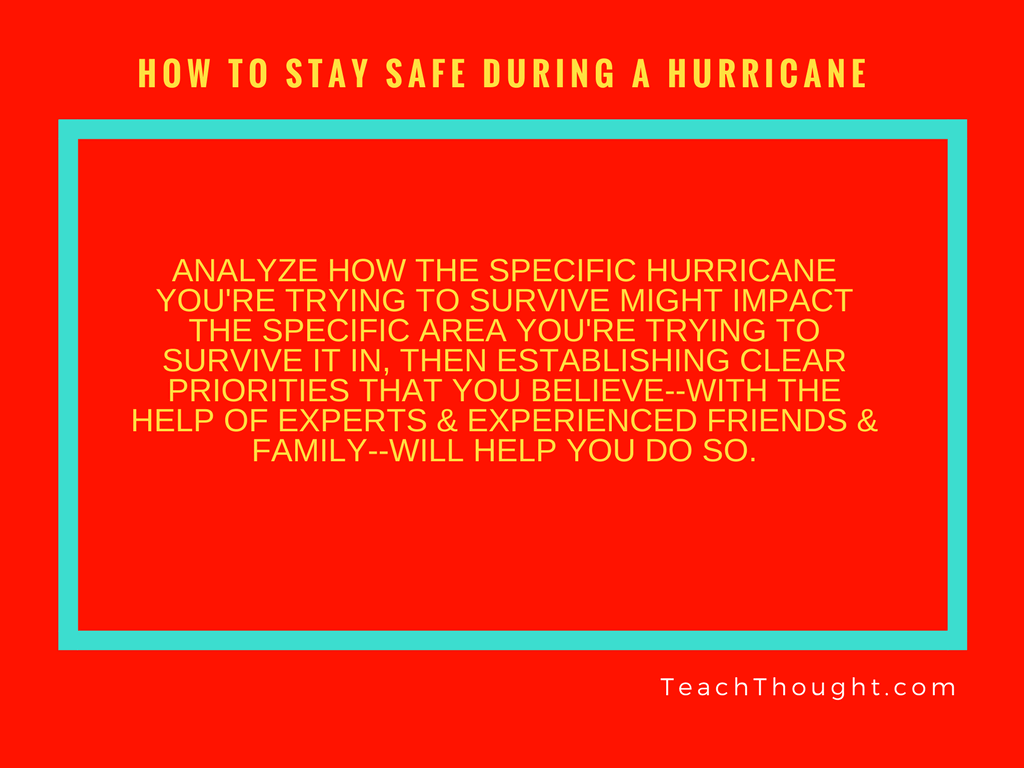
Staying Safe During A Hurricane
by Terry Heick
Right off the bat, let me say that I’m (very obviously) not an expert in hurricanes. If you want government-endorsed and specific FEMA-created checklists, you’re not going to get that here.
I used to fly airplanes as a teen and grew up fascinated with severe weather, but I’m not Jim Cantore. I write–often about critical thinking, learning, futurology, and other nerdy bits. How to survive a hurricane may not be in my wheelhouse, but how to think about how to stay safe in a hurricane is.
(If you want to get right to the ‘How To Stay Safe During A Hurricane’ bit, scroll down. First, some backstory–especially for those wondering why we’re writing about Hurricane safety on TeachThought.)
Climate change is impacting our planet in very clear and often unpredictable ways.
A warmer planet earth is melting polar ice caps, causing glaciers to recede, bleaching the Great Barrier Reef, and most visibly in September 2017, leading to historic weather events including Hurricane Harvey and Hurricane Irma, which two weeks from now will likely have been replaced in our cultural schema by new hurricanes and/or new signinficant weather events.
See also 6 Hurricane Preparedness Checklists So You Can Make Your Own
Hurricane Information vs Hurricane Safety
After visiting a school in Florida this week, I came within 24 hours of being trapped in the beach peninsula for Hurricane Irma, making it on one of the last flights out.
Once I realized I could end up stuck, I started doing some reading on hurricanes and hurricane safety and noticed a huge chasm between government resources (dry and full of warnings and written with a very governmental tone) and the spectacle of YouTube videos and ‘deadliest hurricanes ever recorded’ fare. There had to be something in-between: readable, useful, credible, and informative.
I started by gathering information to understand the specific threats a hurricane represents, then examining local topography maps and historic flood data and hurricane tracking trends and first-hand videos on twitter and so on to get a sense of what might happen and where, and what I should do in response.
I realized that staying safe in a hurricane was a delicate dance between information, instinct, and ongoing awareness. (That’s the reason you’re getting three hurricane posts in a row, because I spent the time reading and looking and skimming and viewing, and figured it might help someone out there, either for Irma or a future hurricane.)
How To Safe During A Hurricane
So, how can you stay safe during a hurricane? If you can survive the initial winds and storm surge, and navigate the threats of possible flooding and food and water shortages after, you can ‘survive’ a hurricane.’
But of course it’s not that simple–Hurricane Katrina showed that local infrastructure and response matter. Hurricane Harvey showed that one hurricane may dump extraordinary amounts of rain while another overwhelming wind, and that the threat of each is relative to exactly where it is occurring; storm surges are less dangerous than wind the farther you are from coastline and above sea level, and the reverse is also true.
So how to stay safe during a hurricane isn’t a set thing with a universal sequence. If we were to make it universal, it’d have to be a simple matter of priorities, something like Shelter/Sustenance/Morale. That is, let’s focus one these three ideas to guide our preparation.
We could focus on examining what it is we’re protecting–protecting your home, protecting your family, protecting your food sources, protecting your ways in and out of your neighborhood or city and away from hurricane threats, and so on.
Or it could be a matter of chronology–staying safe Before, During, and After the hurricane.
We could also talk about Strategies & Tactics, Tips & Dos and Don’ts, supplies, use the study of previous hurricanes as kinds of ‘simulations’ to imagine how to respond to a hurricane local to you.
Or we could frame it around the specific threats themselves. Since the primary threats of a hurricane–at least initially– are storm surges, flooding, debris and wind damage, you could develop mini-plans to respond to and mitigate the threat for each.
And those are the big ideas of this post–priorities and personalization.
There isn’t a one way to stay safe because there isn’t one hurricane or one ‘place’ to protect, much in the same way there isn’t any ‘best’ way to teach or ‘best’ way to assess. Every circumstance is different, which is why there isn’t any single definitive how-to guide. Otherwise, there’d already be a perfect guide and everyone would use it.
Staying safe during a hurricane is a matter of analyzing how the specific hurricane you’re trying to survive might impact the specific area you’re trying to survive it in, then establishing clear priorities that you believe–with the help of experts and experienced friends and family–will help you do so.
This is where the more general guides come in handy. You can use these kinds of lists and tips to create your own plan based on the priorities you created for yourself and our family.
For a more ‘everyman’ writeup, lifehacker has a nice post here.
How To Stay Safe During A Hurricane
